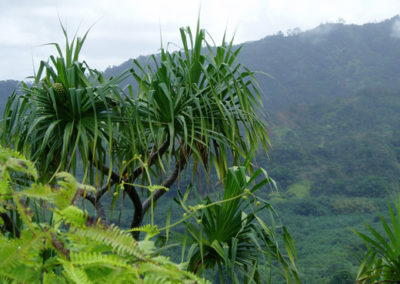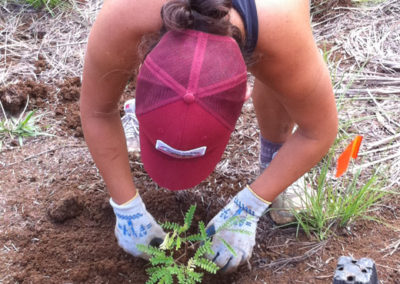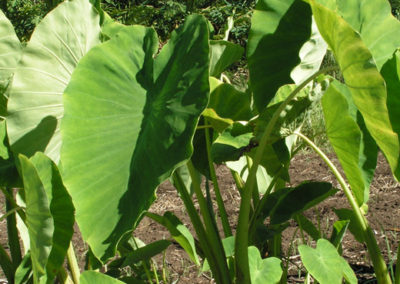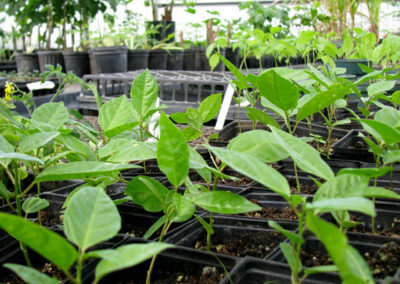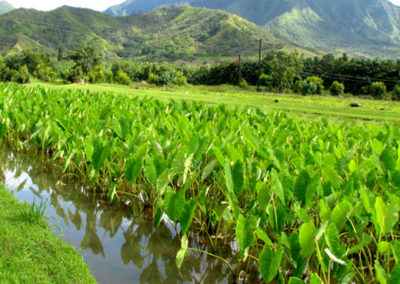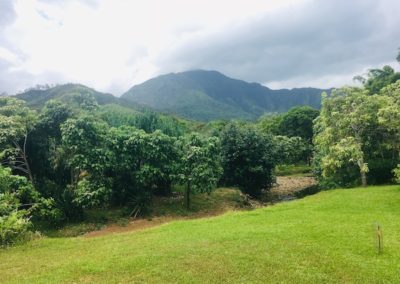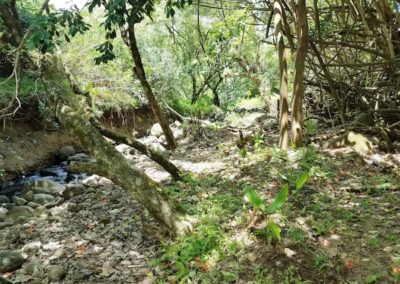Mālama `Āina

`Āina Restoration & Learning Sites
Malama `Āina , to care for the land and natural resources. The Waipā Foundation implements programs in the context of managing the ahupua’a of Waipā, which encompasses 1,600 acres, mauka to makai. Two of our long-range malama`āina goals are:
~~ To restore the health of the natural environment and native ecosystems of the ahupuaa, and to involve our community in the stewardship, restoration, and management of the land and resources within the ahupua’a of Waipā.
~~ To practice and foster social, economic and environmental sustainability in the management of Waipā’s natural and cultural resources.
MAUKA
Mauka means “Towards the mountains”. In ancient times the mauka zone of the ahupua`a was known as Wao Akua, or the realm of the gods, where people rarely went. These areas were important as they yielded such items as wood for canoes and bird feathers for capes and other items for the ali`i.
Through today, the native forests of the uplands are important as they are the vast sponge that absorbs fresh rain water, which seeps into the ground, flows down to the valleys in streams, and keeps the people of Hawai`i, and our crops, alive.
As in many areas throughout Hawai`i, Waipāʻs uplands were deforested by the sandalwood trade, cattle ranching, and forest fire allowing non-native grasses, shrubs and trees to invade. An important part of our work and learning at Waipā is actively restoring forest while sharing the value of healthy upland ecosystems and their important relationship to rest of the watershed. Clearing of invasive weeds and grasses and planting of Koai`a and other native species began in 2004 and to date over 5,000 trees have been planted by Waipā staff and volunteers on over 10 acres. Sadly, over the years, the black twig borer has decimated many of the Koai`a trees.
Today we are both expanding and re-planting many of these areas in mixed forest including food plants, canoe plants and natives, hoping that a diverse forest will be more resilient.
KULA
Kula means plain, field, open country or pasture. The kula zone of the ahupua`a include the flat lands between the mountains and the sea, where food is grown and people live. Today we honor the traditional value and use of this area by working toward food sovereignty for our community. Growing and eating from this ‘ āina.
LO‘I KALO
Waipāʻs lo`i kalo currently encompass about 6 acres in rotation and is farmed and managed by Waipāʻs team along with volunteers and program participants. For years the primary function of Waipāʻs lo`i kalo was as an experiential learning site for our programs. Today, increasing Waipāʻs kalo production has become a focus as well. An additional 6 acres of lo’i kalo within Waipā are cultivated by two other mahi’ai(farmers) and their ‘ohana, utilizing the same auwai, or water system, as our ancestors have for hundreds of years.
GARDENS, ORCHARDS AND PLANT NURSERY
Throughout the kula zone of Waipā are small scale production gardens, orchards, and plantings of natives, canoe plants and modern introductions useful for food and fiber. These plants are imporant to our programs for weaving, to make dyes, kapa, and for other cultural and medicinal uses. Produce is prepared and consumed within programs, turned into value added products in Laukupu kitchen and sold at our farmers market, our self-serve produce fridge and to local restaurants, juice bars and food trucks. Seedlings are propagated and grown for outplanting in all areas of Waipā in our on-site nursery.
MAKAI
MAKAI
Ma-kai means “towards the sea”. Traditionally, ocean resources provided the main source of protein in the Hawaiian diet. Hawaiian fisheries were strictly regulated and considered a primary source of subsistence, rather than a recreational area as they are commonly known and utilized today. Coastal conservation and management practices maintain healthy and abundant nearshore ecosystems, beaches and estuaries. Learning about our resources and creating adaptive management strategies is Waipāʻs kuleana, a continuation of our cultural values and practices, and supports their availability and abundance.
Halulu Fishpond
At the muliwai (estuary) of Waiʻoli steam is Halulu, a loko iʻa or fishpond. Hawaiians had many different archetypes of fishponds, Halulu is of the loko puʻuone type. Unlike the more well-known loko kuapā, it does not have a rock wall, but rather takes advantage of a puʻuone or sand dune to separate it from the ocean. In 2002, Waipā Foundation received funding from NOAA to reopen one acre of the 7-acre Halulu fishpond, which over the last 50+ years had been almost completely overtaken by invasive species. Its connection to Waiʻoli Stream was re-established and native plants were reintroduced along its banks. This expanded the Waiʻoli stream estuary area by one acre, adding more safe, healthy, nutrient rich habitat for the pua, or baby fish, to thrive. We hope that this results in increased fish population in the pond, stream and Hanalei Bay, so that our keiki will continue to eat fish for generations to come. This area also functions as a learning site, where classes and groups come to learn about the importance of the muliwai and kai areas of the ahupuaʻa.
Managing invasive species in and around the pond is both fun and beneficial. The work includes pulling and composting Water Hyacinths, and decreasing the Tilapia community in our pond, by catching and eating them, or using them for fertilizer for the gardens. Since we have connected the pond to Wai‘oli stream, we have observed an increase in size and type of native fish and invertebrate populations in the pond, and a decrease in tilapia.
Waʻa and Ocean Education
Waʻa (canoes) are sea-going vessels used for fishing, transportation, and long-distance journeys. The waʻa brought our people to Hawaiʻi. The waʻa is often considered to be symbolic of an island: where Hawaiian sustainable practices, interdependencies, and cultural knowledge / values were paramount.
Many place names along Waiʻoli and Waipā ahupuaʻa boundaries are named after parts of a waʻa and have connections to stories involving waʻa. Waipā has aspired to develop programs with funding support from our donors and partners and the physical effort and design skills of our community. With threats of ocean warming, sea level rise, coral bleaching, and dwindling sea food resources, Waipā desires to strengthen and develop the ocean education. Efforts toward developing ocean stewardship and education programming started with community members building four paddling and sailing waʻa:
Hoʻomau – a six-man outrigger paddling canoe, made from Albizia wood
Māmalahoa – a six-man outrigger paddling canoe, made of fiberglass.
Kauila – a thirty-foot-long, single-hull, sailing canoe.
Keakealani – a thirty-foot-long, double-hull, Hawaiian sailing canoe.
Waipa’s fleet currently includes:
Kahekili & Uakaua – two four man hulls that can be rigged separately or together for both paddling and sailing.
KAHAWAI
Stream Restoration Project
Our kahawai is Waipā Stream, flowing from mauka to makai. In between the manowai, where stream water is diverted to the lo’i, and the muliwai, or estuary, a segment of Waipā Stream had become densely overgrown with Hau Bush and other invasive plants, to the point where the stream channel was essentially clogged. Concerns about water quality and habitat for the native ‘o’opu fish in this area inspired a project to open up the stream corridor and let the stream flow freely once again. Little by little, we’ve been restoring function and health to this area of the ahupua’a, by removing invasive streamside vegetation and replacing it with native plants as well as introduced plants such as Ulu (Breadfruit), Niu (Coconut Palm), and Mai’a (Banana) that served as important food sources before and hopefully will again.
Waipā Stream has changed so much already in this restoration site, with rocky and sandy substrate replacing silt and muck. New limu growth, a response to sunlight finally reaching the streambed, provides a food source for our native ‘o’opu. Water quality is slowly improving as flow conditions improve, and fish populations are on the rise. Even after a historic flood in April 2018, when nearly 50 inches of rain fell at Waipā in 24 hours, we have observed improving conditions in our kahawai. The progress achieved on this project so far could not have been possible without funding support from The U.S. Fish and Wildlife Service, the National Fish and Wildlife Foundation, NOAA, the State of Hawaii Dept. of Health and and the EPA, The Hawaii Community Foundation, Kamehameha Schools, and substantial involvement from partners and volunteers from Kaua`i, Hawai`i and beyond. We invite you to learn more about the Waipā Stream Restoration Project through the link below, and welcome you to join us for hands-on learning through our Community Volunteer Workdays (held on the 4th Saturday of every month).






